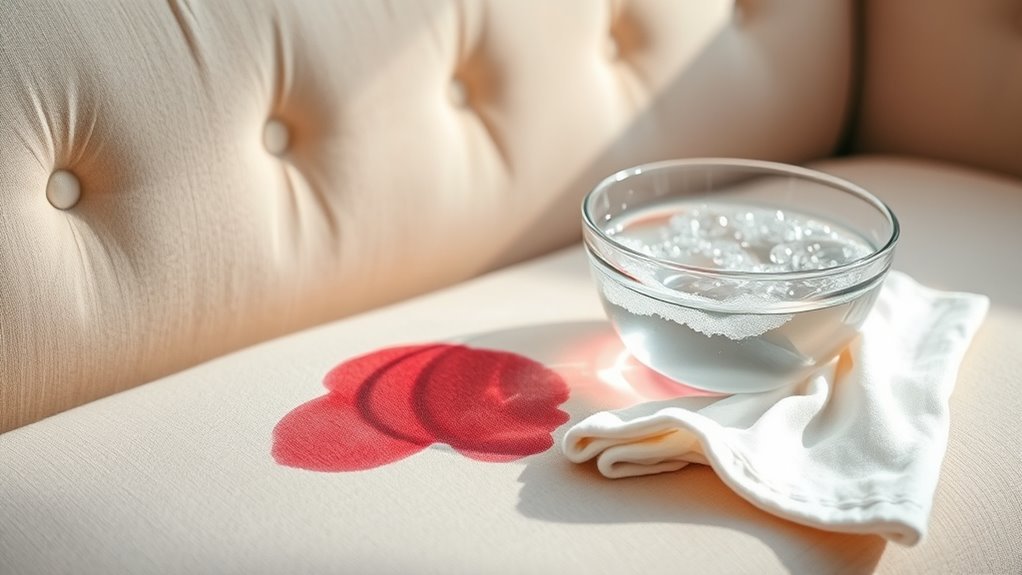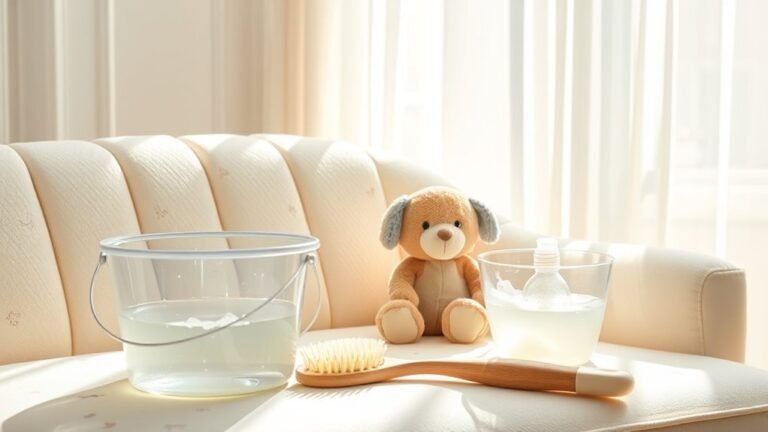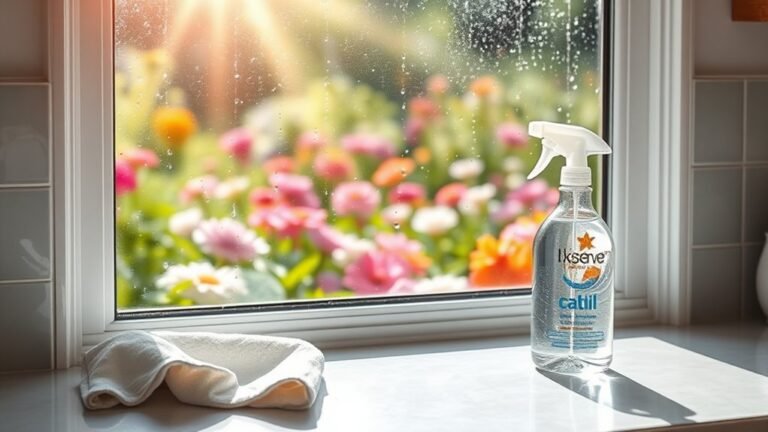How to Remove Stains From Upholstered Furniture
To remove stains from your upholstered furniture, start by identifying the fabric type to choose the safest cleaning method. Act quickly by blotting spills without rubbing, and test solutions on a hidden spot first. Use common household items like dish soap, vinegar, or rubbing alcohol depending on the stain. Always rinse and let the fabric air dry. For tough or delicate stains, knowing when to call a professional can save your furniture. Keep going for detailed tips and tricks.
Identifying Different Types of Upholstery Fabrics

Before you can effectively remove stains, you’ll need to identify the type of upholstery fabric you’re dealing with. Different fabric types—from natural fibers like cotton and linen to synthetics like polyester and microfiber—have varying levels of stain resistance. Knowing what you’re working with gives you the freedom to choose the best cleaning method without risking damage. Some fabrics, like leather or treated synthetics, offer more stain resistance, making cleanup easier. Others, such as silk or untreated cotton, require extra care to avoid permanent marks. Take a moment to check the manufacturer’s label or test a small, hidden spot. This way, you’re empowered to tackle stains confidently, preserving your furniture’s look and your peace of mind.
Common Stains and Effective Cleaning Solutions
Although stains on upholstered furniture can seem challenging, knowing the right cleaning solutions makes tackling them much easier. Whether it’s wine stains or grease stains, each requires a specific approach to restore your freedom from stubborn marks. Here’s a quick guide to common stains and how to handle them:
| Stain Type | Effective Cleaning Solution |
|---|---|
| Wine stains | Blot with cold water, then use a mix of dish soap and hydrogen peroxide |
| Grease stains | Sprinkle baking soda, let sit, then vacuum and apply dish soap solution |
| Ink stains | Rubbing alcohol applied with a cloth |
| Coffee stains | Mix vinegar and water, blot gently |
| Mud stains | Let dry, brush off, then clean with mild detergent |
Knowing these solutions helps you keep your furniture looking fresh and stain-free.
Step-by-Step Stain Removal Techniques

When you tackle stains on your upholstered furniture, having a clear, step-by-step approach makes the process much simpler and more effective. Embracing DIY cleaning empowers you to restore your furniture’s beauty without relying on professionals. Here’s how to get started:
- Act quickly to blot, not rub, preventing stain setting.
- Test your cleaning solution on a hidden spot to avoid damage.
- Use gentle, circular motions to lift stains without spreading them.
- Rinse with a damp cloth to remove residue and prevent buildup.
- Let the fabric air dry fully to avoid mildew and odor.
Following these steps gives you freedom from stubborn stains while promoting long-lasting stain prevention. You’ll confidently maintain your furniture’s charm and enjoy a fresh, stain-free space.
Preventative Tips to Protect Your Upholstered Furniture
Taking care of stains promptly helps keep your furniture looking great, but preventing stains from happening in the first place makes maintenance even easier. You can enjoy freedom from constant worry by applying fabric protection and committing to regular maintenance. Simple habits can truly extend your upholstery’s life.
| Tip | Benefit | How To Implement |
|---|---|---|
| Use Fabric Protection | Repels spills & stains | Spray protectant after cleaning |
| Regular Maintenance | Keeps fabric fresh | Vacuum weekly, spot clean |
| Designated Eating Zones | Limits food stains | Keep food off furniture |
When to Call Professional Upholstery Cleaners

Wondering if it’s time to call in a professional for your upholstery cleaning? Sometimes, tackling stains yourself isn’t worth risking damage or wasting time. Keep an eye out for these red flags that signal you should trust the experts and their proven cleaning methods:
- Stains that won’t budge, no matter what you try
- Upholstery fabric that’s delicate or vintage
- Lingering odors despite your efforts
- Extensive dirt buildup or pet hair embedded deep
- Fear of using harsh chemicals ruining your freedom to choose
When you spot these signs, calling a pro can save your furniture and your peace of mind. Letting skilled cleaners handle tough stains means you enjoy your space without restrictions or worry. Freedom starts with knowing when to ask for help.
Frequently Asked Questions
Can Upholstery Stains Cause Permanent Fabric Damage?
Yes, upholstery stains can cause permanent fabric damage if you don’t act fast. You’ll want to embrace stain prevention techniques and fabric care tips to keep your furniture looking fresh and free. Regular cleaning and quick attention to spills help protect your freedom to enjoy your space without worrying about ruined upholstery. Staying proactive means your fabrics stay vibrant and strong, letting you relax without the stress of permanent stains.
Are Natural Cleaning Products Safe for All Upholstery Types?
When it comes to natural cleaner effectiveness, you shouldn’t assume they’re safe for every upholstery type—it’s not always a walk in the park. While many natural products are gentle, fabric compatibility varies widely. You’ll want to test any cleaner on a hidden spot first to avoid surprises. Embracing natural options gives you freedom from harsh chemicals, but always check your furniture’s care label to keep your upholstery looking its best without risking damage.
How Often Should Upholstery Be Professionally Cleaned?
You’ll find frequency recommendations for professional upholstery cleaning vary, but a good rule of thumb is every 12 to 24 months. Depending on your lifestyle and how much use your furniture gets, you might want to adjust your cleaning schedules to keep things fresh. If you’ve got kids, pets, or allergies, more frequent cleanings make sense. Ultimately, you set the pace—choose what fits your freedom and comfort best.
Will Stain Removers Affect Upholstery Color or Texture?
Did you know 70% of upholstery stains can be safely treated if you test first? When using stain remover types like enzymatic or solvent-based, always do colorfastness testing on a hidden spot. This helps you avoid unwanted fading or texture changes. You want to keep your furniture looking fresh without restrictions, so testing guarantees your fabric’s color and feel stay intact, giving you freedom to clean confidently.
Can Pets’ Behavior Influence Upholstery Stain Frequency?
Absolutely, your pet habits play a big role in how often you deal with upholstery stains. If your furry friend tends to jump on furniture or drools a lot, you’ll notice more messes. Sticking to regular cleaning routines helps keep stains at bay and preserves your furniture’s look. By understanding your pet’s habits and adjusting your cleaning approach, you can enjoy a fresh, free-spirited home without constant worry about stains.






